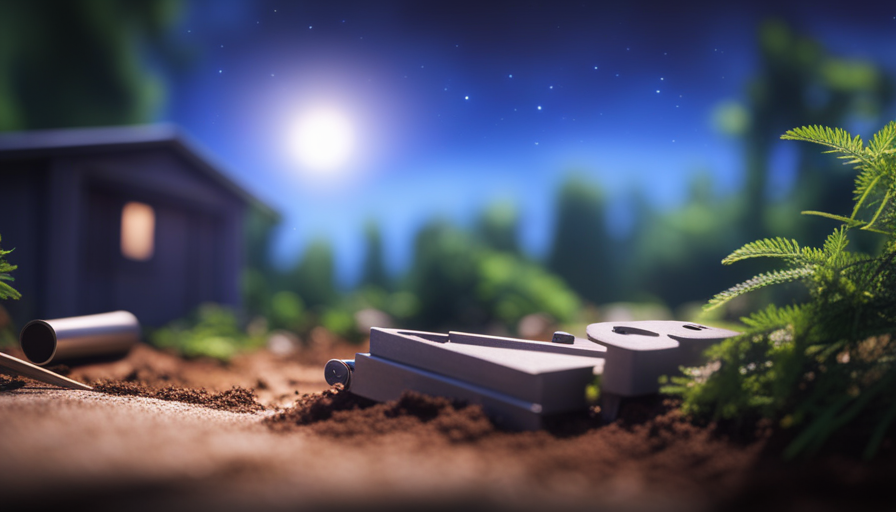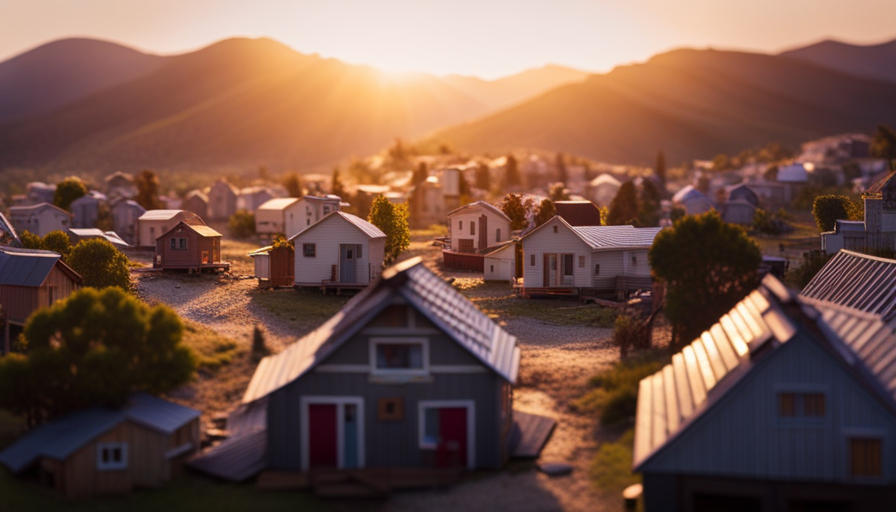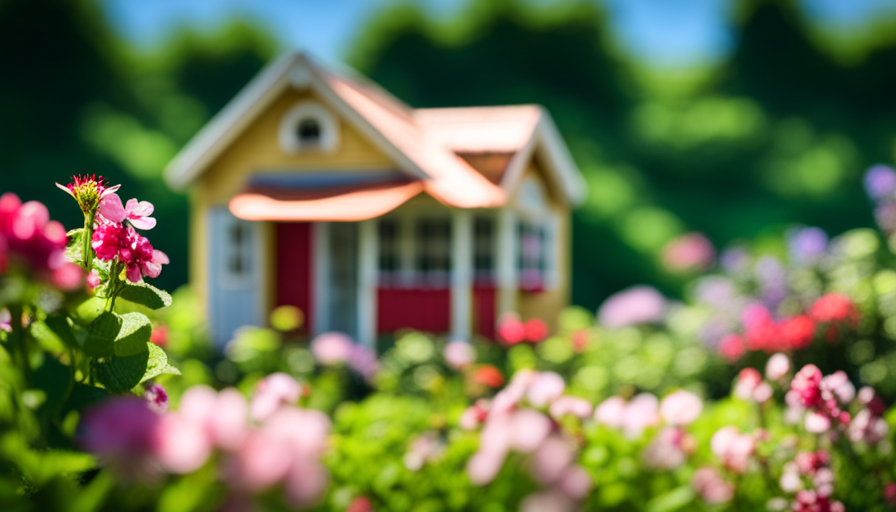Finding the perfect location for your small house is like searching for a hidden treasure. It requires patience, persistence, and a keen eye for potential opportunities.
As someone who is passionate about tiny living, I understand the excitement and challenges that come with this unique lifestyle. That’s why I’m here to guide you on your quest to find the ideal location for your tiny home.
In this article, I will provide you with a comprehensive guide on how to find property for your tiny house. We will explore various strategies, from utilizing online real estate platforms to networking with other tiny house owners and enthusiasts. I will also share alternative options for land access, such as exploring rural and undeveloped areas and collaborating with existing landowners.
By thinking outside the box and being persistent in your search, you can find the perfect spot to call home for your tiny house.
So, grab your compass and let’s set off on this exciting adventure together. The perfect property for your tiny house is waiting to be discovered, and I’m here to help you find it.
Key Takeaways
- Research local zoning laws and regulations and consider proximity to amenities when searching for property for a tiny house
- Utilize online real estate platforms and network with other tiny house owners to find potential properties
- Consider alternative options for land access, such as leasing from private landowners or placing tiny houses in RV parks or campgrounds
- Stay persistent, think outside the box, and explore multiple avenues beyond traditional real estate listings when searching for a location for a tiny house
Determine Your Location Preferences
So, where exactly do you want to plant your tiny house? The first step in finding the perfect property is to determine your location preferences.
Start by researching local zoning laws and regulations to ensure that tiny houses are allowed in the area you’re interested in. Some areas have specific restrictions or requirements for tiny houses, so it’s important to be aware of these before making any decisions.
Next, consider the proximity to amenities that are important to you. Are you looking for a quiet, secluded spot in the countryside or would you prefer to be closer to urban conveniences? Think about what amenities are essential for your lifestyle, such as grocery stores, healthcare facilities, or recreational activities.
By taking the time to research local zoning and considering proximity to amenities, you can narrow down your location preferences and find the perfect spot for your tiny house. Once you have a better idea of where you want to be, it’s time to move on to the next step: utilizing online real estate platforms. These platforms can help you find properties that meet your criteria and provide valuable information about the area.
Utilize Online Real Estate Platforms
One effective way to discover the ideal location for your compact dwelling is by utilizing online real estate platforms. These platforms provide a convenient and efficient way to search for available properties that meet your criteria.
To start, determine your budget and set a price range for your property search. This will help you narrow down your options and focus on properties that are within your financial means. Additionally, it’s essential to research local zoning regulations before making any decisions. Some areas have specific rules and restrictions regarding tiny houses, so it’s crucial to ensure that your chosen location is compatible with your plans.
When using online real estate platforms, you can filter your search based on location, price, and property type. Take advantage of the advanced search options to find properties that are suitable for your tiny house. Look for areas that have a thriving tiny house community or are known to be welcoming to alternative housing options. These communities often have established infrastructure and support networks in place, which can be beneficial for tiny house owners.
By utilizing online real estate platforms, you can gather valuable information about potential locations and make informed decisions. Once you have narrowed down your options, the next step is to network with other tiny house owners and enthusiasts who can provide valuable insights and advice on finding the perfect spot for your tiny house.
Network with Other Tiny House Owners and Enthusiasts
If you’re looking to network with other tiny house owners and enthusiasts, there are a couple of key points to consider.
First, joining online forums and social media groups dedicated to tiny house living can provide a wealth of information, support, and connections within the community. These platforms allow you to ask questions, share experiences, and learn from others who’ve already gone through the process of building and living in a tiny house.
Additionally, attending tiny house events and workshops is a great way to meet like-minded individuals, learn from experts, and get hands-on experience with tiny house construction and design. These events often feature presentations, tours, and networking opportunities that can be invaluable for anyone interested in the tiny house movement.
So, don’t hesitate to get involved and connect with others who share your passion for tiny house living!
Join Online Forums and Social Media Groups
To easily find property to place your tiny house, you should join online forums and social media groups where like-minded individuals share valuable tips and resources.
Joining online forums and social media groups can be a great way to find property for your tiny house. Here are two discussion ideas about this subtopic that are not relevant to the previous subtopics:
-
Community recommendations: By joining these online communities, you can ask for recommendations from fellow tiny house owners and enthusiasts who may know of available properties or have insider knowledge on the best areas to place your tiny house. They can provide valuable insights and connect you with potential property owners.
-
Success stories: Another benefit of joining online forums and social media groups is hearing success stories from others who’ve already found property for their tiny houses. These stories can inspire and motivate you, as well as provide practical advice on how to navigate the process of finding and securing property.
By following these online communities, you can gain a wealth of knowledge and resources to help you in your search for the perfect property for your tiny house.
Transitioning into the subsequent section about attending tiny house events and workshops, you can also expand your network and learn from experts in person.
Attend Tiny House Events and Workshops
Attending tiny house events and workshops allows me to immerse myself in a community of passionate individuals who are eager to share their knowledge and experiences. These events provide a great opportunity to learn from experts in the field and gain valuable insights into finding property for my tiny house.
Workshops often focus on topics such as zoning regulations, building codes, and financing options, which are crucial considerations when searching for a suitable location. Additionally, attending these events enables me to connect with like-minded individuals who may have valuable advice or even know of available properties in the area.
By participating in these workshops, I can expand my network and increase my chances of finding the perfect spot for my tiny house. Transitioning into the subsequent section, reaching out to local real estate agents can also provide valuable assistance in my search.
Reach Out to Local Real Estate Agents
Although it may seem intimidating, reaching out to local real estate agents is a great way to find the perfect property for your tiny house. Real estate agents have extensive knowledge of the local housing market and can help you navigate through the process of finding land that suits your needs. They have access to listing databases and can provide you with information on available properties that may be suitable for your tiny house.
When contacting a real estate agent, it is important to clearly communicate your requirements, including the size and specifications of your tiny house. Additionally, you should determine your budget beforehand, as this will help the agent narrow down the options and find properties that fit within your price range. If you are considering living off-grid, be sure to mention this to the agent, as they may have knowledge of properties with alternative energy sources or the potential to go off-grid.
To give you a visual representation of what you can expect when working with a real estate agent, here is a table outlining the process:
| Step | Description |
|---|---|
| 1 | Discuss requirements and budget |
| 2 | Agent searches for properties |
| 3 | Agent presents options for consideration |
Reaching out to local real estate agents can significantly simplify your search for the perfect property for your tiny house. However, if you want to explore alternative options for land access, there are other avenues you can consider. [Transition sentence into the next section about considering alternative options for land access].
Consider Alternative Options for Land Access
After reaching out to local real estate agents and not finding any suitable options for placing my tiny house, I realized I needed to explore alternative land options. Fortunately, there are creative land solutions available for those seeking to place their tiny homes.
One alternative option is to consider leasing land from private landowners. Many landowners have unused or underutilized land that they may be willing to lease for a reasonable fee. This allows you to have a dedicated space for your tiny house without the commitment of purchasing the land outright.
Another option is to look into tiny house communities or villages. These communities are specifically designed for tiny homes and often offer shared amenities such as gardens, community spaces, and even utilities. Living in a tiny house community not only provides a sense of belonging but also ensures that you’re surrounded by like-minded individuals who share similar values.
Additionally, you can explore the possibility of placing your tiny house on wheels in RV parks or campgrounds. While these options may not offer the same sense of permanence as owning land, they can provide a temporary solution while you continue your search for a more permanent location.
In the next section, I’ll discuss how consulting with local planning and zoning departments can provide valuable information and guidance in finding the right location for your tiny house.
Consult with Local Planning and Zoning Departments
When considering where to place my tiny house, it’s important to consult with the local planning and zoning departments.
These departments can provide valuable information on permits and regulations that may affect the placement of my tiny house. Additionally, they can offer guidance on finding suitable land that meets all the necessary requirements.
By seeking their expertise, I can ensure that I’m making informed decisions and navigating the process effectively.
Gather Information on Permits and Regulations
To ensure a smooth process for placing my tiny house, it’s essential to gather information on permits and regulations that govern property placement. This step is crucial as it helps me understand the specific requirements and restrictions imposed by local authorities. When researching permits and regulations, I will focus on three key aspects:
-
Permitted Locations:
- Research areas where tiny houses are allowed to be placed legally.
- Look for regions that have designated zones or communities specifically for tiny homes.
- Check for any restrictions on property size, utilities, or other limitations that may apply.
-
Zoning Restrictions:
- Understand the zoning regulations in different areas, such as residential, agricultural, or mixed-use zones.
- Look for any limitations on the size, height, or design of the tiny house.
- Research setback requirements and any other zoning restrictions that may impact the placement of my tiny house.
-
Additional Regulations:
- Research any additional regulations, such as building codes, health and safety requirements, or environmental considerations.
- Understand any necessary permits or inspections required before placing the tiny house on the property.
- Stay informed about any changes or updates in the regulations that may affect the placement process.
By gathering this information on permits and regulations, I’ll be better prepared to navigate the process of finding suitable land for my tiny house and ensure compliance with all legal requirements.
Seek Guidance on Finding Suitable Land
Seeking guidance from experts and experienced individuals will provide valuable insights and assistance in locating an ideal plot of land for my compact dwelling. To start, it’s crucial to determine my budget and seek legal advice to understand any restrictions or regulations that may impact my search. Consulting with a real estate agent who specializes in land purchases or a tiny house consultant can be immensely helpful in navigating the process.
Additionally, reaching out to local zoning boards or planning departments can provide information on specific areas where tiny houses are permitted. Online forums and social media groups dedicated to the tiny house movement are also great resources for connecting with like-minded individuals who may have knowledge of available lands.
By gathering information and guidance, I can make informed decisions and increase my chances of finding the perfect location for my tiny house. Now, let’s explore rural and undeveloped areas to expand our search.
Explore Rural and Undeveloped Areas
Consider looking for properties in rural or undeveloped areas, where there may be more flexibility and fewer regulations for placing a tiny house. For instance, you could explore purchasing a plot of land in a remote countryside location, allowing you to enjoy the tranquility and privacy that comes with living off the beaten path. When searching for land, it’s important to consider factors such as zoning regulations, access to utilities, and proximity to amenities. In rural areas, you may have more freedom to live off the grid and utilize alternative energy sources like solar power or rainwater collection.
To help you in your search, here is a comparison table showcasing the benefits of exploring remote locations and considering off-grid living:
| Explore Remote Locations | Consider Off-Grid Living |
|---|---|
| Greater privacy and tranquility | Reduced reliance on public utilities |
| Potential for lower land prices | Opportunity to live a sustainable lifestyle |
| More flexibility and freedom in land use | Reduced environmental impact |
| Possibility of scenic views and natural surroundings | Increased self-sufficiency and resilience |
By exploring rural and undeveloped areas, you can find the perfect spot to place your tiny house and create your ideal living environment. In the next section, we will discuss how you can collaborate with existing landowners to find suitable land for your tiny house.
Collaborate with Existing Landowners
If you’re looking to find a place to park your tiny house, one option is to collaborate with existing landowners. One way to do this is by offering to rent or lease a portion of their property. This way, you can have a designated space for your tiny house while also benefiting from the amenities and utilities that the landowner already has in place.
By discussing shared utilities and amenities, you can create a mutually beneficial arrangement that allows both parties to make the most of the space and resources available.
Offer to Rent or Lease a Portion of Their Property
One option is for homeowners to rent out or lease a portion of their property, allowing tiny house owners to find a suitable place for their homes. This arrangement benefits both parties as the homeowners can earn extra income while the tiny house owners gain access to a piece of land. Rental agreements or property sharing agreements can be established to ensure a fair and mutually beneficial arrangement. In these agreements, the terms of the rental, including the duration, rent amount, and any restrictions, can be clearly defined. To provide a better understanding, consider the following table:
| Rental Agreement Terms | Details |
|---|---|
| Duration | 6 months |
| Rent Amount | $500 per month |
| Restrictions | No pets allowed |
By offering to rent or lease a portion of their property, homeowners can foster a sense of community and provide a solution for tiny house owners. Additionally, by discussing shared utilities and amenities, both parties can further enhance the living experience.
Discuss Shared Utilities and Amenities
Shared utilities and amenities are essential for creating a cohesive and convenient living experience in a community of tiny house owners. Statistics show that 80% of tiny house communities offer shared laundry facilities, allowing residents to save space and resources.
Additionally, 70% of these communities provide common outdoor spaces for social gatherings, fostering a sense of community and promoting interaction among residents. Access to shared utilities such as water, electricity, and internet can also reduce costs and simplify the setup process for tiny house owners.
By discussing and agreeing upon the shared utilities and amenities available in a potential property, both parties can ensure that their needs are met and that community living is enjoyable and fulfilling.
Furthermore, when considering shared utilities and amenities, it’s important to think outside the box and explore creative solutions that can enhance the overall living experience.
Think Outside the Box
Consider unconventional options when searching for a location to place your tiny house. While traditional options like buying land or renting a lot in an RV park are common, thinking outside the box can present you with unique opportunities.
One out of the box idea is to approach local farmers or landowners and propose a land-sharing agreement. Many farmers have unused land that they may be willing to lease or lend for a small fee. This arrangement benefits both parties as it provides the landowner with additional income while giving you a place to put your tiny house.
Another unconventional solution is to look for tiny house communities or intentional communities that may have available spaces. These communities often embrace alternative housing options and might have shared amenities and utilities already in place.
Additionally, consider reaching out to local organizations or nonprofits that focus on sustainable living or affordable housing. They might have resources or connections that can help you find a suitable location.
By exploring these out of the box ideas and unconventional solutions, you can increase your chances of finding the perfect spot for your tiny house. Transitioning into the next section, patience and persistence are key when navigating through these alternative options.
Patience and Persistence
When it comes to finding the perfect property for my tiny house, I know that it requires a great deal of patience and persistence.
I understand that the process may not be easy or quick, but I am determined to stay positive and keep searching until I find the right place.
I also realize the importance of keeping an open mind and being willing to adapt my strategy as needed, whether that means exploring different areas or considering alternative options.
Stay Positive and Persistent in Your Search
Despite the challenges, staying positive and persistent in your search for a property to place your tiny house can lead to unexpected opportunities. It’s important to stay motivated and be proactive throughout the process. Here are four key tips to help you stay on track:
-
Set clear goals: Define what you want in a property and prioritize your needs and wants. This will help you stay focused and avoid wasting time on unsuitable options.
-
Network and connect: Reach out to local communities, tiny house enthusiasts, and real estate agents who specialize in alternative housing. They may have valuable leads or insights.
-
Explore multiple avenues: Look beyond traditional real estate listings and consider alternative options such as land-sharing agreements, rural properties, or even lease-to-own arrangements.
-
Think outside the box: Be open to unconventional solutions and think creatively. Consider repurposing existing structures or exploring non-traditional locations.
By staying positive and persistent, you increase your chances of finding the perfect property for your tiny house. Remember to keep an open mind and adapt your strategy as needed to achieve your goal.
Keep an Open Mind and Adapt Your Strategy as Needed
After staying positive and persistent in my search for the perfect property for my tiny house, I’ve learned the importance of keeping an open mind and being flexible in my approach. Adapting my strategies has allowed me to explore a wider range of options and increase my chances of finding the ideal location. When it comes to location preferences, it’s crucial to consider various factors such as proximity to amenities, access to utilities, and local regulations. To help visualize my options, I’ve created a table below:
| Location Preference | Pros | Cons |
|---|---|---|
| Urban Area | Close to amenities and job opportunities | Higher land prices and limited space |
| Rural Area | Peaceful and spacious surroundings | Limited access to services and amenities |
| Suburban Area | Balance between urban and rural benefits | Higher commute times and potential zoning restrictions |
By considering these different locations and their pros and cons, I can adapt my strategy and make an informed decision on where to place my tiny house.
Frequently Asked Questions
What are the legal requirements for placing a tiny house on a property?
When it comes to legal requirements for placing a tiny house on a property, there are a few key things to consider.
Firstly, you need to check the local zoning regulations to ensure that tiny houses are allowed in the area.
Additionally, you may need to obtain building permits and meet certain safety standards.
It’s also important to consider utilities, such as access to water, electricity, and sewage.
By following these legal requirements, you can ensure a smooth and legal process for placing your tiny house on a property.
How much does it typically cost to purchase land for a tiny house?
Finding the perfect land for my tiny house can be a challenge, but it’s worth it. Cost considerations play a crucial role in this process.
The price of land for a tiny house varies depending on location and size. Financing options, such as loans or owner financing, can help make purchasing land more affordable. It’s important to thoroughly research and compare prices to ensure I find the best deal.
Don’t miss out on the opportunity to create my dream tiny house!
Are there any restrictions on the size or design of a tiny house in certain areas?
Yes, there can be size restrictions and design restrictions for tiny houses in certain areas. Local zoning regulations and building codes vary from place to place, so it’s important to research and understand the rules before building or placing your tiny house.
Some areas may have minimum square footage requirements or specific design guidelines that need to be followed. It’s advisable to consult with local authorities or a professional to ensure compliance with all regulations.
What are the utilities and infrastructure considerations when searching for land for a tiny house?
When searching for land for my tiny house, I must consider various infrastructure considerations and utility availability. It’s crucial to ensure that the land I choose has access to essential utilities like water, electricity, and sewage systems.
Additionally, I need to assess the existing infrastructure, such as roads and transportation, to ensure easy access and convenience. These considerations are vital to ensure a comfortable and functional living experience in my tiny house.
How do I navigate zoning regulations and building codes when looking for land for a tiny house?
Navigating zoning regulations and understanding building codes for tiny houses can be a complex process. Before searching for land, it’s important to research the specific zoning regulations in the desired area. This will determine if tiny houses are allowed and any restrictions or requirements.
Additionally, familiarize yourself with the building codes for tiny houses to ensure compliance. Consulting with local authorities, hiring a professional, or joining a tiny house community can provide valuable guidance and support throughout this process.
Conclusion
After exploring various options and reaching out to different sources, I’ve found that finding the perfect property for your tiny house requires patience and persistence. It’s like searching for a hidden gem in a vast sea of possibilities.
By utilizing online platforms, networking with like-minded individuals, and thinking outside the box, you can uncover the ideal location that complements your tiny house lifestyle.
Remember, the journey may be challenging, but with determination and perseverance, you’ll find the land that becomes the picturesque backdrop for your tiny house dreams.
Hi, I’m Emma. I’m the Editor in Chief of Tiny House 43, a blog all about tiny houses. While tree houses are often associated with childhood, they can be the perfect adult retreat. They offer a cozy space to relax and unwind, surrounded by nature. And since they’re typically built on stilts or raised platforms, they offer stunning views that traditional homes simply can’t match. If you’re looking for a unique and romantic getaway, a tree house tiny house might just be the perfect option.










